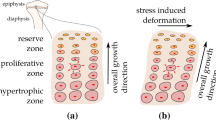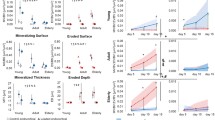Abstract
We have developed an improved mechanobiological model of bone morphogenesis and functional adaptation that includes the influences of periosteum tension and pressure on bone formation and resorption. Previous models assumed that periosteal and endosteal bone deposition and resorption rates are governed only by the local intracortical daily stress or strain stimulus caused by cyclic loading. The new model incorporates experimental findings that pressures on periosteal surfaces can impede bone formation or induce bone resorption, whereas periosteal tensile strains perpendicular to bone surfaces can impede bone resorption or induce bone formation. We propose that these effects can produce flattened or concave bone surfaces in regions of periosteal pressure and bone ridges in regions of periosteal tension. The model was implemented with computer simulations to illustrate the role of adjacent muscles on the development of the triangular cross-sectional geometry of the rat tibia. The results suggest that intracortical stresses dictate bone size, whereas periosteal pressures may work in combination with intracortical stresses and other mechanobiological factors in the development of local bone cross-sectional shapes.
Similar content being viewed by others
References
Agur AMR, Lee MJ (1999) Grant’s Atlas of anatomy, 10th edn. Lippincott Williams and Wilkins, Philadelphia
Amprino R (1985) The influence of stress and strain in the early development of shaft bones. An experimental study on the chick embryo tibia. Anat Embryol (Berl) 172:49–60
Arnett TR, Gibbons DC, Utting JC, Orris IR, Hoebertz A, Rosendaal M, Meghji S (2003) Hypoxia is a major stimulator of osteoclast formation and bone resorption. J Cell Physiol 196:2–8
Beaupré GS, Orr TE, Carter DR (1990a) An approach for time-dependent bone modeling and remodeling–theoretical development. J Orthop Res 8:651–661
Beaupré GS, Orr TE, Carter DR (1990b) An approach for time-dependent bone modeling and remodeling-application: a preliminary remodeling simulation. J Orthop Res 8:662–670
Biewener AA (1991) Musculoskeletal size in relation to body size. J Biomech 24 (Suppl) 1:19–29
Boppart MD, Kimmel DB, Yee JA, Cullen DM (1998) Time course of osteoblast appearance after in vivo mechanical loading. Bone 23:409–415
Carter DR, Beaupré GS (2001) Skeletal function and form: mechanobiology of skeletal development, aging, and regeneration. Cambridge University Press, Cambridge, UK
Carter DR, Fyhrie DP, Whalen RT (1987) Trabecular bone density and loading history: regulation of connective tissue biology by mechanical energy. J Biomech 20:785–794
Carter DR, Harris WH, Vasu R, Caler WE (1981) The mechanical and biological response of cortical bone to in vivo strain histories. In: Mechanical properties of bone-AMD, Vol. 45. The American Society of Mechanical Engineers, New York, pp 81–92
Cowin SC (1984) Mechanical modeling of the stress adaptation process in bone. Calcif Tissue Int 36:S98–S103
Cowin SC, Hart RT, Balser JR, Kohn DH (1985) Functional adaptation in long bones: establishing in vivo values for surface remodeling rate coefficients. J Biomech 18:665–684
Crandall SH, Dahl NC (1959) An introduction to the mechanics of solids. McGraw-Hill, New York
Cullen DM, Smith RT, Akhter MP (2000) Time course for bone formation with long-term external mechanical loading. J Appl Physiol 88:1943–1948
Currey JD, Alexander RM (1985) The thickness of the walls of tubular bones. J Zool Lond 206:453–468
Donaldson HH (1924) The rat: data and reference tables for the albino rat (Mus norvegius albinus) and the Norway rat (Mus norvegius), Philadelphia
Ek AC, Gustavsson G, Lewis DH (1987) Skin blood flow in relation to external pressure and temperature in the supine position on a standard hospital mattress. Scand J Rehabil Med 19:121–126
Evans HE, Christensen GC (1979) Miller’s anatomy of the dog. Saunders, Philadelphia
Feik SA, Storey E, Ellender G (1987) Stress induced periosteal changes. Br J Exp Pathol 68:803–813
Fong KD, Nacamuli RP, Loboa EG, Henderson JH, Fang TD, Song HM, Cowan CM, Warren SM, Carter DR, Longaker MT (2003) Equibiaxial tensile strain affects calvarial osteoblast biology. J Craniofac Surg 14:348–355
Fyhrie DP, Carter DR (1986) A unifying principle relating stress to trabecular bone morphology. J Orthop Res 4:304–317
Gooding CA, Glickman MG, Suydam MJ (1969) Fate of rib notching after correction of aortic coarctation. Am J Roentgenol Radium Ther Nucl Med 106:21–23
Hall RF Jr., Watt DH (1986) Osseous changes due to a false aneurysm of the proper digital artery: a case report. J Hand Surg [Am] 11:440–442
Hamburger V, Waugh M (1940) The primary development of the skeleton in nerveless and poorly innervated limb transplants of chick embryos. Physiol Zool 13:367–384
Hart RT, Davy DT, Heiple KG (1984) Mathematical modeling and numerical solutions for functionally dependent bone modeling. Calcif Tissue Int 36:S104–S109
Henderson JH, Carter DR (2002) Mechanical induction in limb morphogenesis: the role of growth-generated strains and pressures. Bone 31:645–653
Henderson JH, Longaker MT, Carter DR (2004) Sutural bone deposition rate and strain magnitude during cranial development. Bone 34:271–280
Huiskes R, Weinans H, Grootenboer HJ, Dalstra M, Fudala B, Slooff TJ (1987) Adaptive bone-remodeling theory applied to prosthetic-design analysis. J Biomech 20:1135–1150
Ikegame M, Ishibashi O, Yoshizawa T, Shimomura J, Komori T, Ozawa H, Kawashima H (2001) Tensile stress induces bone morphogenic protein 4 in preosteoblastic and fibroblastic cells, which later differentiate into osteoblasts leading to osteogenesis in the mouse calvariae in organ culture. J Bone Miner Res 16:24–32
Iwasaki LR, Crouch LD, Reinhardt RA, Nickel JC (2004) The velocity of human orthodontic tooth movement is related to stress magnitude, growth status, and the ratio of cytokines in gingival crevicular fluid. In: Biological mechanisms of tooth movement and craniofacial adaptation. Harvard Society for the Advancement of Orthodontics, Boston
Jaworski ZF, Liskova-Kiar M, Uhthoff HK (1980) Effect of long-term immobilisation on the pattern of bone loss in older dogs. J Bone Joint Surg Br 62-B:104–110
Jepsen KJ, Davy DT (1997) Comparison of damage accumulation measures in human cortical bone. J Biomech 30:891–894
Kaneko TS, Pejcic MR, Tehranzadeh J, Keyak JH (2003) Relationships between material properties and CT scan data of cortical bone with and without metastatic lesions. Med Eng Phys 25:445–454
Kanno T, Takahashi T, Ariyoshi W, Haga M, Nishihara T (2005) Tensile mechanical strain up-regulates Runx2 and osteogenic factor expression in human periosteal cells: implications for distraction osteogenesis. J Oral Maxillofac Surg 63:499–504
Kanzaki H, Chiba M, Shimizu Y, Mitani H (2002) Periodontal ligament cells under mechanical stress induce osteoclastogenesis by receptor activator of nuclear factor kappaB ligand up-regulation via prostaglandin E2 synthesis. J Bone Miner Res 17:210– 220
Kay ED, Condon K (1987) Skeletal changes in the hindlimbs of bipedal rats. Anat Rec 218:1–4
King GJ, Keeling SD, Wronski TJ (1991) Histomorphometric study of alveolar bone turnover in orthodontic tooth movement. Bone 12:401–409
Kotha SP, Hsieh YF, Strigel RM, Muller R, Silva MJ (2004) Experimental and finite element analysis of the rat ulnar loading model-correlations between strain and bone formation following fatigue loading. J Biomech 37:541–548
Lanyon LE (1980) The influence of function on the development of bone curvature. An experimental study on the rat tibia. J Zool 192:457–466
Lanyon LE, Baggott DG (1976) Mechanical function as an influence on the structure and form of bone. J Bone Joint Surg Br 58-B: 436–443
Lanyon LE, Hampson WG, Goodship AE, Shah JS (1975) Bone deformation recorded in vivo from strain gages attached to the human tibial shaft. Acta Orthop Scand 46:256–268
Levenston ME, Beaupré GS, Carter DR (1998) Loading mode interactions in simulations of long bone cross-sectional adaptation. Comput Methods Biomech Biomed Eng 1:303–319
Lieberman DE, Polk JD, Demes B (2004) Predicting long bone loading from cross-sectional geometry. Am J Phys Anthropol 123:156–171
Loboa EG, Fang TD, Warren SM, Lindsey DP, Fong KD, Longaker MT, Carter DR (2004) Mechanobiology of mandibular distraction osteogenesis:experimental analyses with a rat model. Bone 34:336–343
Martens M, Van Audekercke R, De Meester P, Mulier JC (1981) The geometrical properties of human femur and tibia and their importance for the mechanical behaviour of these bone structures. Arch Orthop Trauma Surg 98:113–120
Martin TJ, Ng KW (1994) Mechanisms by which cells of the osteoblast lineage control osteoclast formation and activity. J Cell Biochem 56:357–366
McClure RC, Dallman MJ, Garrett PD (1973) Anatomy of the cat: an atlas, text, and dissection guide. Lea and Febiger, Philadelphia
Mikic B, Carter DR (1995) Bone strain gage data and theoretical models of functional adaptation. J Biomech 28:465–469
Mosley JR, Lanyon LE (1998) Strain rate as a controlling influence on adaptive modeling in response to dynamic loading of the ulna in growing male rats. Bone 23:313–318
Orisek BS, Chole RA (1987) Pressures exerted by experimental cholesteatomas. Arch Otolaryngol Head Neck Surg 113:386–391
Pearson OM, Lieberman DE (2004) The aging of Wolff’s “law”: ontogeny and responses to mechanical loading in cortical bone. Am J Phys Anthropol Suppl 39:63–99
Peterman MM, Hamel AJ, Cavanagh PR, Piazza SJ, Sharkey NA (2001) In vitro modeling of human tibial strains during exercise in microgravity. J Biomech 34:693–698
Qin Y-X, Kaplan T, Saldanha A, Rubin C (2003) Fluid pressure gradients, arising from oscillations in intramedullary pressure, is correlated with the formation of bone and inhibition of intracortical porosity. J Biomech 36:1427–1437
Ráliš ZA, Ráliš HM, Randall M, Watkins G, Blake PD (1976) Changes in shape, ossification and quality of bones in children with spina bifida. Dev Med Child Neurol Suppl:29–41
Reilly DT, Burstein AH (1975) The elastic and ultimate properties of compact bone tissue. J Biomech 8:393–405
Roberts WE, Chase DC (1981) Kinetics of cell proliferation and migration associated with orthodontically-induced osteogenesis. J Dent Res 60:174–181
Rubin CT, Lanyon LE (1984) Dynamic strain similarity in vertebrates; an alternative to allometric limb bone scaling. J Theor Biol 107:321–327
Rudwick MJS (1997) Georges Cuvier, fossil bones, and geological catastrophes. The University of Chicago Press, Chicago
Ruff CB, Holt B, Trinkaus E (2006) Who’s afraid of the big bad Wolff? “Wolff’s law” and bone functional adaptation. Am J Phys Anthropol 129:484–498
Ruff CB, Hayes WC (1982) Subperiosteal expansion and cortical remodeling of the human femur and tibia with aging. Science 217:945–948
Salim A, Nacamuli RP, Morgan EF, Giaccia AJ, Longaker MT (2004) Transient changes in oxygen tension inhibit osteogenic differentiation and Runx2 expression in osteoblasts. J Biol Chem 279:40007–40016
Sato T, Hara T, Mori S, Shirai H, Minagi S (1998) Threshold for bone resorption induced by continuous and intermittent pressure in the rat hard palate. J Dent Res 77:387–392
Schmidt BL, Kung L, Jones C, Casap N (2002) Induced osteogenesis by periosteal distraction. J Oral Maxillofac Surg 60:1170–1175
Skedros JG, Hunt KJ, Bloebaum RD (2004) Relationships of loading history and structural and material characteristics of bone:development of the mule deer calcaneous. J Morphol 259:281–307
Skripitz R, Aspenberg P (2000) Pressure-induced periprosthetic osteolysis: a rat model. J Orthop Res 18:481–484
Sikes SK (1971) The Natural History of the African Elephant. American Elsevier Publishing Company, Inc., New York
Sontag W (1992) Age-dependent morphometric alterations in the distal femora of male and female rats. Bone 13:297–310
Teng S, Herring SW (1998) Compressive loading on bone surfaces from muscular contraction: an in vivo study in the miniature pig, Sus scrofa. J Morphol 238:71–80
van der Meulen MCH, Beaupré GS, Carter DR (1993) Mechanobiologic influences in long bone cross-sectional growth. Bone 14:635–642
von Böhl M, Maltha JC, Von Den Hoff JW, Kuijpers-Jagtman AM (2004) Focal hyalinization during experimental tooth movement in beagle dogs. Am J Orthod Dentofacial Orthop 125:615–623
Voyvodic F, Sage MR, Brophy BP (1992) Intracerebral ganglioglioma. Australas Radiol 36:153–154
Wang K, Hodges M (1994) Images in cardiovascular medicine. Erosion of lumbar vertebral bodies due to abdominal aortic aneurysm. Circulation 89:1317
Wang L, Fritton SP, Weinbaum S, Cowin SC (2003) On bone adaptation due to venous stasis. J Biomech 36:1439–1451
Yeh JK, Liu CC, Aloia JF (1993) Effects of exercise and immobilization on bone formation and resorption in young rats. Am J Physiol 264(2 Pt 1):E182–9
Yochum TR, Rowe LJ (2005) Yochum and Rowe’s essentials of skeletal radiology, 3rd edn. Lippincott Williams and Wilkins, Baltimore
Author information
Authors and Affiliations
Corresponding author
Rights and permissions
About this article
Cite this article
Carpenter, R.D., Carter, D.R. The mechanobiological effects of periosteal surface loads. Biomech Model Mechanobiol 7, 227–242 (2008). https://doi.org/10.1007/s10237-007-0087-9
Received:
Accepted:
Published:
Issue Date:
DOI: https://doi.org/10.1007/s10237-007-0087-9




